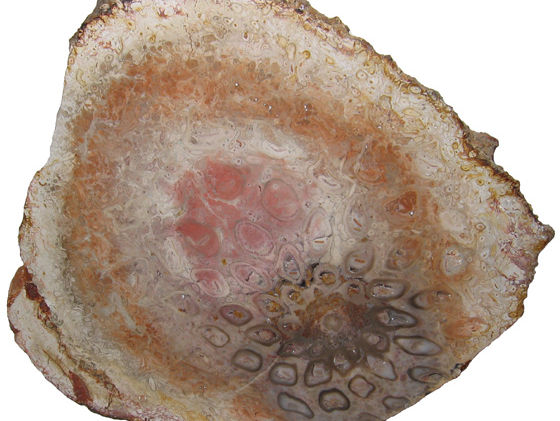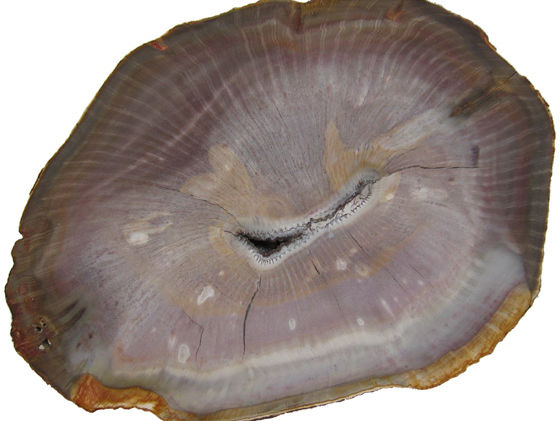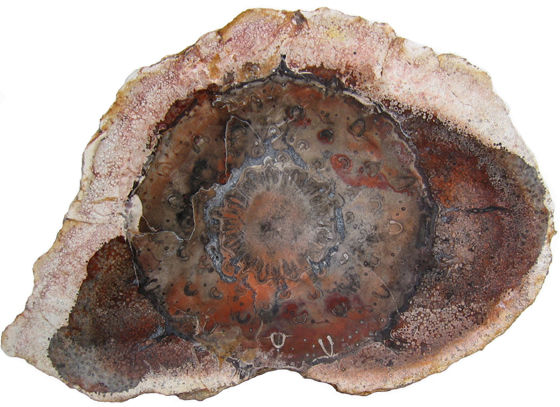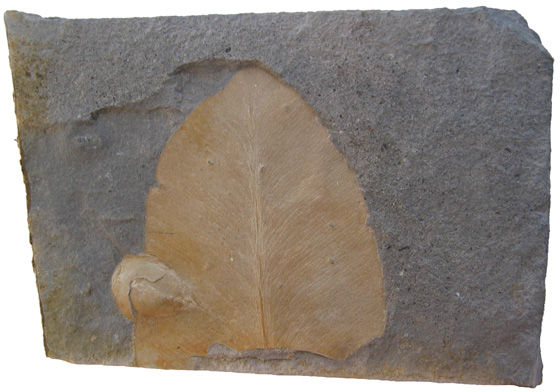Permian Period: 299-251 Million Years Ago
The Permian period spans from 299 to 251 million years ago. This geologic period was named after province of Perm in the former U.S.S.R. where rocks of this age were first studied (USGS). Sir Roderick Impey Murchison (1792-1871) a Scottish geologist named the Permian in 1841. The transition into the Permian was relatively uneventful, but a cooling and drying trend during the Permian would affect the distribution and diversity of organisms. The Permian would end with an abrupt warming trend and the largest mass extinction.
Primary Producers & Reefs
The dominant primary producers in the oceans continue to be cyanobacteria, green and red algae (Knoll, Summons, Waldbauer, and Zumberge, 2007, p. 148). Calcareous algae and calcareous sponges were the most important reef builders during the Permian (Stanley, 1987, p. 101). Stromatolites, corals, bryozoans, and brachiopods were also a part of reef ecosystems. In many Permian reef systems the problematic Archaeolithoporella was important in binding reefs with carbonates (Webb, 2001, p. 176) and (Grimm, 2008, slide 16).
Plants
At the beginning of the Permian, the clubmosses, horsetails, ferns, seed ferns, and cordaites, which had dominated the Carboniferous, continued to flourish. Indeed half of all known plant species at this time were clubmosses, which today account for less than 1 percent (Kenrick & Davis, 2004, p. 141). As the Permian progressed swamp forests would contract and eventually be replaced by new floras. In the early Permian these changes occurred in North America and Europe. In China these changes would not occur until the late Permian. In many Permian forests the canopy became dominated by cordaites, tree ferns like Psaronius and horsetails like Calamites. Seed ferns (Pteridosperms) like Medullosa also accounted for a good percentage of the plant life while the role of lycopsids decreased. A particular order of seed ferns, Glossopteridales, is of particular interest. Glossopteris was a seed-bearing shrub or tree. Glossopteris reached heights of 4 m. The trunk was made of araucariod-like wood; leaves were tongue-shaped and bore slender stalks with clusters of organs containing seeds and pollen. In the early Permian Glossopteris appears in Gondwana, but spreads across Pangea by the end of the Permian. Glossopteris fossils are found in South America, Africa, India, Antarctica, and Australia. The distribution of Glossopteris was a key piece of biological evidence that supported Continental Drift (Kenrick & Davis, 2004, pp. 154-157). Conifers became more diverse and more abundant towards the end of the Permian. In some locations Dadoxylon, a type of Araucaria, are among the largest and most numerous trunks (Dernbach & Tidwell, 2002, p. 119). Ginkgophytes make their first undisputed appearance in the Permian; however, the genus Ginkgo does not appear until the Mesozoic (Taylor, Taylor, and Krings, 2009, p. 744).
Plant life can be divided into geologic eras that differ from that of the familiar animal eras of Paleozoic (ancient life), Mesozoic (middle life), and Cenozoic (recent life). Plant eras include the Paleophytic (ancient plant--Silurian-Permian), Mesophytic (middle plant--Triassic-Early Cretaceous), and Cenophytic (recent plant--Late Cretaceous to present). Clubmosses, horsetails, and ferns, which all reproduce with spores constituted the dominant floras of the Paleophytic. The conifers, which reproduce using seeds, would be the dominant floras of the Mesophytic (Kenrick & Davis, 2004, p. 143).
The Greatest Mass Extinction
The Permian period ended with the largest recorded mass extinction that hit both aquatic and terrestrial environments. It is estimated that 75 to 90 percent of all living species became extinct over a period of 10 million years (Stanley, 1987, pp. 96-97). Sixty percent of marine families became extinct (Palmer, 1999, p. 90). In the marine realm crinoids, brachiopods, bryozoans, and ammonoids were hit hard. Fusulinids, trilobites, graptolites, blastoids, rugose corals, tabulate corals, and eurypterids met with extinction. Among the fish Acanthodians and Placoderms became extinct. Rhipidistians, lobe-finned fish (Osteichthyes) that are the ancestors of land vertebrates also went extinct. Extinction in the marine realm marked a change from a Paleozoic dominated fauna composed of crinoid, coral, bryozoan, and brachiopods to a modern fauna dominated by bivalves, gastropods, and echinoids (Prothero, 2004, p. 86).
Two-thirds of the amphibian and reptile families met with extinction. The larger terrestrial vertebrates did not fare as well. Thirty-three percent of amphibian families went extinct at the end of the Permian (Palmer, 1999, p. 90). Among the amphibians some labyrinthodonts would survive into the Triassic. Lepospondyls (Lepospondyli) amphibians went extinct by the end of the Permian. All but one group of anapsid type reptiles died out. The fossil evidence for diapsid reptiles is sparse during the mid Permian, although many new groups make their first appearance during the late Permian. The most primitive groups of diapsids went extinct at the end of the Permian (Dixon, 1988, p. 84). The first synapsids were the pelycosaurs, which made up 70% of the vertebrate terrestrial fauna in the early Permian. During the middle Permian another group of synapsids, the therapsid, would evolve and displace the pelycosaurs. Pelycosaurs died out in the middle Permian. Therapsids would loose 21 families at the end of the Permian (Palmer, 1999, p. 90).
For the first time insects suffered a mass extinction. Many of the primitive orders of insects went extinct during the Permian event. Among the fixed-winged insects (Paleoptera) the following orders went extinct: Palaeodictyoptera, Megasecoptera, Diaphanopterodea, and Protodonata. Among the folded-winded insects with incomplete metamorphosis (exopterygota Neoptera) the following orders went extinct: Protorthoptera, Caloneurodea, Protelytroptera, and Miomoptera) (Carpenter & Burnham, 1985, p. 302). Insect fossils found after the Permian belong mostly to modern insect groups.
Globally, plants experienced their greatest losses during the Permian extinction. Only 9 out of 22 known families survived into the Triassic (Cleal & Thomas, 2009, p. 209). As noted earlier, the swamp forests of the Carboniferous contracted during the Permian. As the clubmosses waned, ferns and primitive conifers expanded to take their place. The change from Paleophytic to Mesophytic flora occurred over a period of 25 million years. Tropical plant ecosystems suffered major disruptions with some extinction at the end of the Permian period. Cordaites went extinct as well as the seed fern Glossopteris. The dominant conifer families (Walchiaceae, Ullmanniaceae, and Majonicaceae) of the time went extinct. For a geologically short time, woody coniferous forests were replaced by herbaceous species of clubmosses and quillworts (4-5 million years). In the Triassic, woody coniferous forests of a different type would be reestablished (Kenrick & Davis, 2004, p. 154).
Uranium-lead zircon geochronology has been used to date ash layers, associated with the Siberian Traps, at the Permian-Triassic boundary in Southern China. The results establish a date of 251 Ma (Wignall, 2001, p. 8). The extinction interval is thought to be very short on the order of 165,000 years or less (Prothero, 2004, p. 87). What caused the "mother of all extinctions?"
An increase in dune deposits, evaporite salts, and a lack of coal forming swamps may indicate arid conditions in some terrestrial environments. There is evidence of a marine regression, which would reduce habitat in shallow marine environments. A rapid warming trend occurred at the end of the Permian. An increase in O-16 over O-18 in the calcite skeletons of marine organisms indicates global temperatures may have increased by as much as 6 degrees Celsius. An increase in C-12 found in terrestrial and marine sections could be an indication of increased volcanic activity and massive death in the marine and terrestrial realms (Benton, 2003, p. 38). Like the Ordovician and Devonian events a reduction in the formation of marine limestone and reef building occurred after the Permian extinction. Layers containing abundant pyrite above the limestone layers indicate a low oxygen environment.
Onset of flood basalts making up the Siberian Traps occur at the Permian-Triassic boundary. This LIP formed in northern Asia and may have been the source of carbon dioxide that started a global warming event. As the climate warmed methane may have been released from methane clathrates accelerating the warming event. The release of these gasses into the atmosphere is called the "big belch" and may have increased temperatures and lowered oxygen levels (Cleal & Thomas, 2009, p. 209). Climate change may have also altered oceanic circulation in such a way as to bring stagnant deep water rich in carbon dioxide and hydrogen sulfide to the surface. The Permian crises would usher in a new era represented by different flora and fauna evolved from the small percentage of survivors who were, at first, cosmopolitan in their distribution.
References
-
Benton, M.J. (2003). Wipeout. New Scientist. vol 178, issue 2392, p. 38.
-
Carpenter, F.M., & Burnham, L. (1985). The Geologic Record of Insects. Annual Review of Earth and Planetary Sciences 13: 297-314.
-
Cleal C.J. & Thomas, B.A. (2009). Introduction to Plant Fossils. United Kingdom: Cambridge University Press.
-
Dixon, D., Cox, B., Savage, R.J.G., & Gardiner, B. (1988). The Macmillan Illustrated Encyclopedia of Dinosaurs and Prehistoric Animals: A Visual Who’s Who of Prehistoric Life. New York: Macmillan Publishing Company.
-
Kazlev, M.A. (2002). Palaeos Website. see: http://www.palaeos.com/Timescale/default.htmKenrick, P. & Davis, P. (2004). Fossil Plants. Washington: Smithsonian Books
-
Grimm, K.A. (2008). The Permian Reef Complex (Delaware Basin) of West Texas. See: http://www.geology.ubc.ca/resources/index.html
-
Kenrick, P. & Davis, P. (2004). Fossil Plants. Washington: Smithsonian Books.
-
Knoll, Summons, Waldbauer, and Zumberge. (2007). The Geological Succession of Primary Producers in the Oceans. In Falkowski, P.G. Knoll, A.H. [Eds] Evolution of Primary Producers in the Sea. (pp. 133-163). China: Elsevier Academic Press.
-
Prothero, D.R. (2004). Bringing Fossils to Life: An Introduction to Paleobiology [2nd edition]. New York: McGraw-Hill.
-
Robler, R. (2002). Between Precious Inheritance and Immediate Experience-Palaobotanical Research from the Permian of Chemnitz, Germany. . In Dernbach, U. & Tidwell, W.D. Secrets of Petrified Plants: Fascination from Millions of Years (pp. 105-119). Germany: D’ORO Publishers.
-
Stanley, S.M., (1987). Extinction. New York: Scientific American Books.
-
Taylor, T.N., Taylor E.L. & Krings, M. (2009). Paleobotany: The Biology and Evolution of Fossil Plants [2nd Ed]. New York: Academic Press.
-
USGS Publication: Major Division of Geologic Time see: http://pubs.usgs.gov/gip/geotime/divisions.html
-
Wignall, P.B. (2001). Large Igneous Provinces and mass extinctions. Earth-Science Reviews. vol 53, pp. 1-33.
























